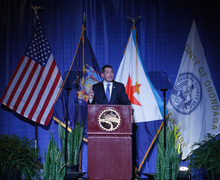King: ‘Looking’ gave gay characters depth, failed to embrace diversity
Last week, HBO’s “Looking” was canceled. After two seasons of panning over the San Francisco skyline and Russel Tovey’s ass, the story of three gay men messily navigating the relationships between themselves and others is over.
“Looking” was a step in the right direction. Having an HBO series that focuses on gay men and sheds light on other queer identities is great, especially when we live in a country where a doctor can refuse care to a child with two gay parents, or where media outlets misgender trans murder victims, or where you can still get fired for being LGBTQI. Despite that, “Looking,” had to go, and I’m going to miss it. But not too much.
I watched “Looking” for the same reason anyone watched “Looking.” Its characters were charming. Patrick, Dom and Augustín were the threesome who were kind of cool, in an awkward way. Most importantly, though, it showed a subset of the population, the gay community, that has been traditionally two-dimensionalized in the past in shows like “Will and Grace.” “Looking” had characters with actual arcs, who developed, whom you cared about, even if you didn’t like them.
It’s hard to talk fairly about representation. “Looking” focuses on three mainly white, mainly wealthy and definitively gorgeous men — that’s fine, their stories matter too. As I’ve said before, shaming a show because it doesn’t agree with the way you experience a culture, even if it is your own, is a veiled way of saying, “I’m not comfortable with this different understanding and so I’ll paint it as being wrong.” “Looking” isn’t wrong, it’s incomplete.
The show fails in representation. Besides Augustín, whose race is ambiguous and does not factor into the narrative anyway; his season one boyfriend, Frank, a man of color; and Richie, Patrick’s former flame, who is Mexican American, the show focuses on gay white men. In some of “Looking”’s most interesting scenes, Richie travels back to his old neighborhood and faces judgment from his family about dating a white man, and a reminder from former acquaintances that his father still resents him. But “Looking” doesn’t dwell on this, and we’re transported back to the idiotic world of Patrick where his biggest problem is sleeping with boss.
Essentially, for a show that has so many opportunities to tell a story about queer people of color — it’s set in San Francisco, for Christ’s sake — it takes so few of those opportunities. And for a show that clearly attempts to aim for diversity, it still can’t shake the feeling of being utterly white.
Queer men of color don’t get a lot of screen time historically speaking. And “Looking” is no exception. The only examples I can think of are Oscar on “The Office,” who took a bit part and made it outshine even Steve Carrell’s Michael Scott at times, and Jamal on “Empire,” the middle child of a homophobic music mogul who has to navigate his intersecting identities of being black and gay.
More recently though, Tituss Burggess plays a clueless white ingénue’s black gay roommate, Titus Andromedon, in “Unbreakable Kimmy Schmidt” on Netflix. The character gave everyone nerves in his first few scenes. “Oh God, another black queen caricature. Yeah, we’ve seen that before.” But the audience soon realized this character is fully formed and well thought through. He has his own dreams and we go with him on his journey to achieve them.
People love Titus — and they love Tituss, Tumblr posts and YouTube clips, New York Times interviews, all flooded in after “Unbreakable”’s debut. They want to see more of him, and they want more queer people of color.
That’s something that they couldn’t, or didn’t, do in “Looking” and audiences deserve better.
Eric King is a sophomore magazine journalism major. His column appears weekly. He can be reached at edking@syr.edu and followed on Twitter @erickingdavid.
Published on March 30, 2015 at 11:29 pm





